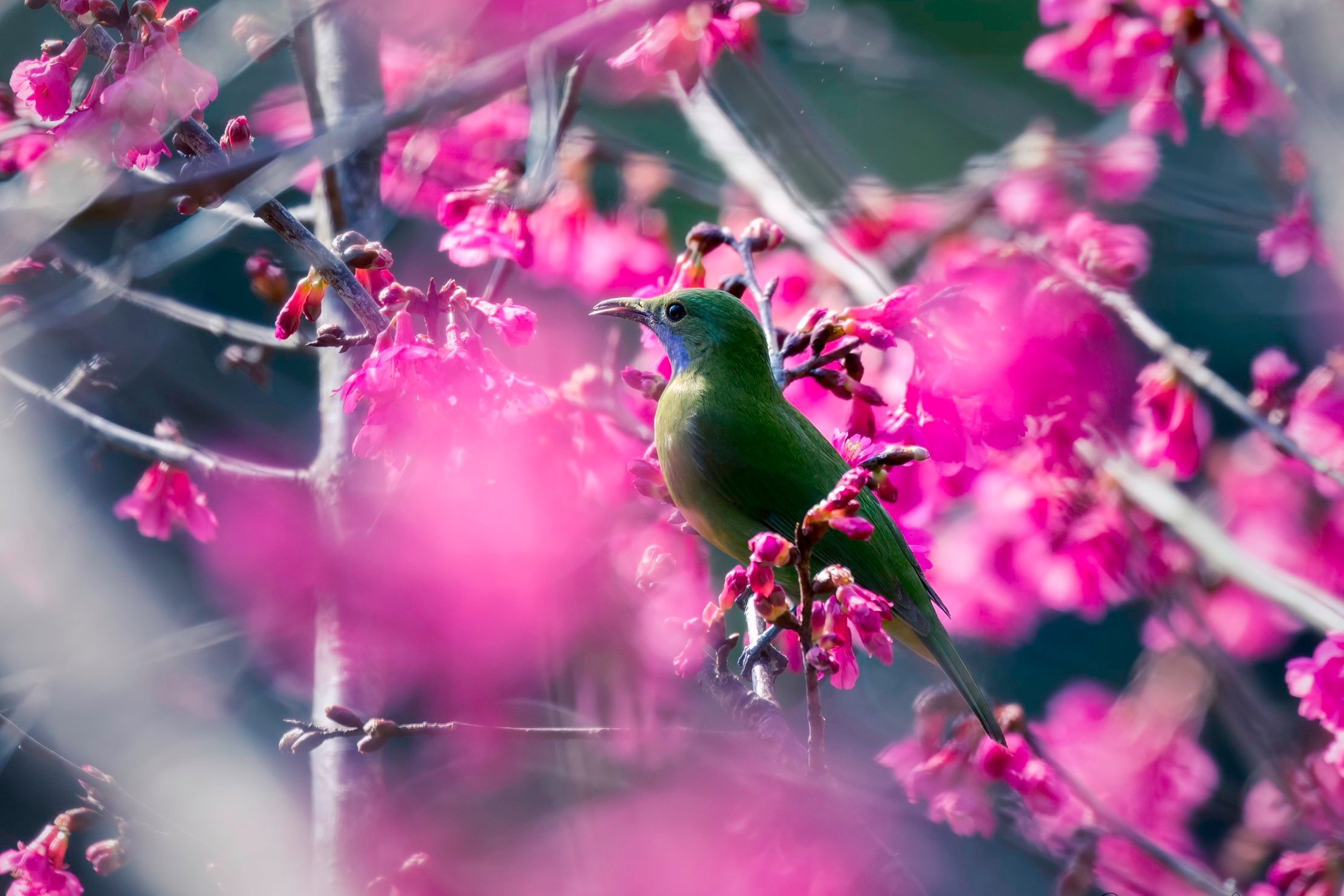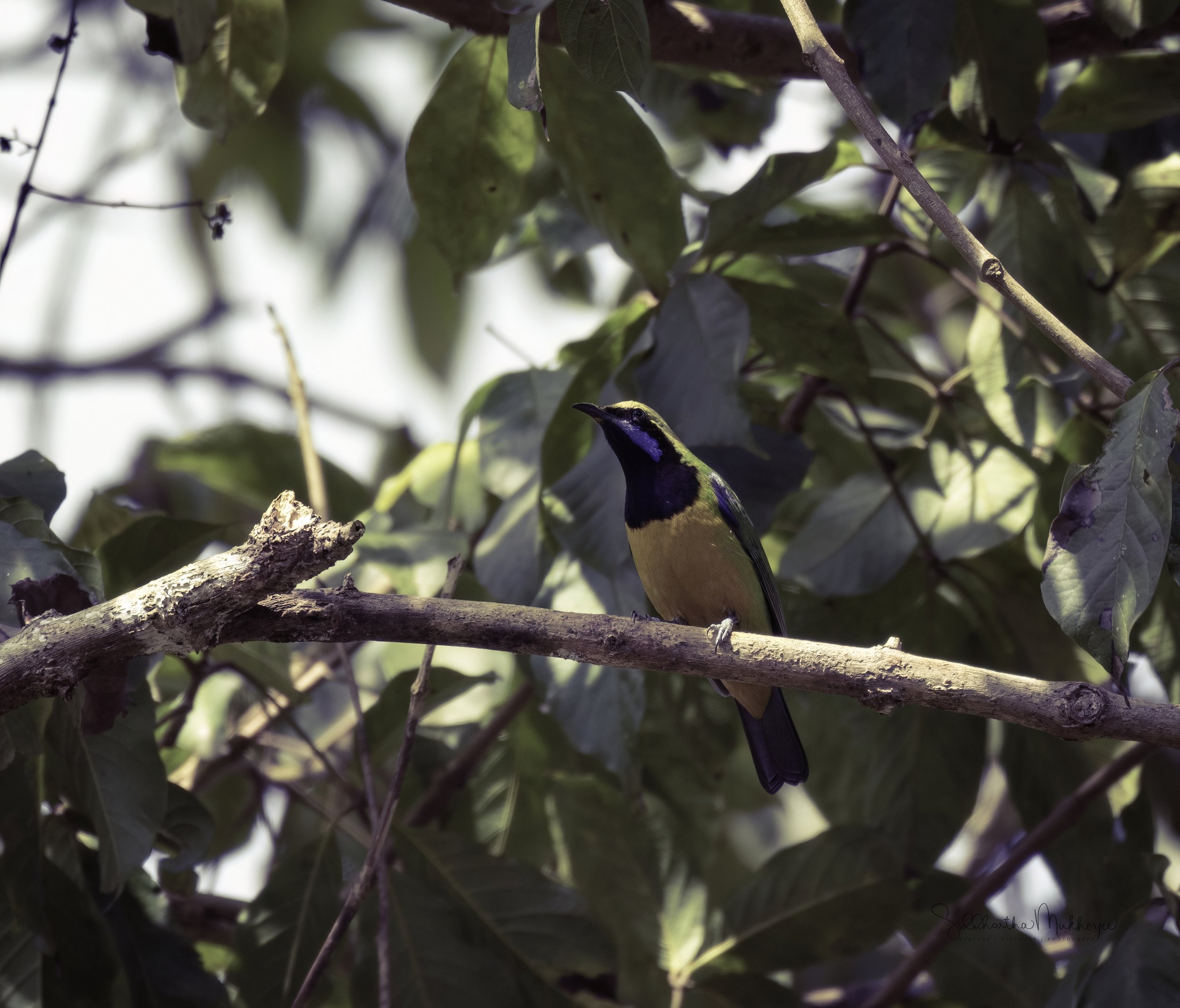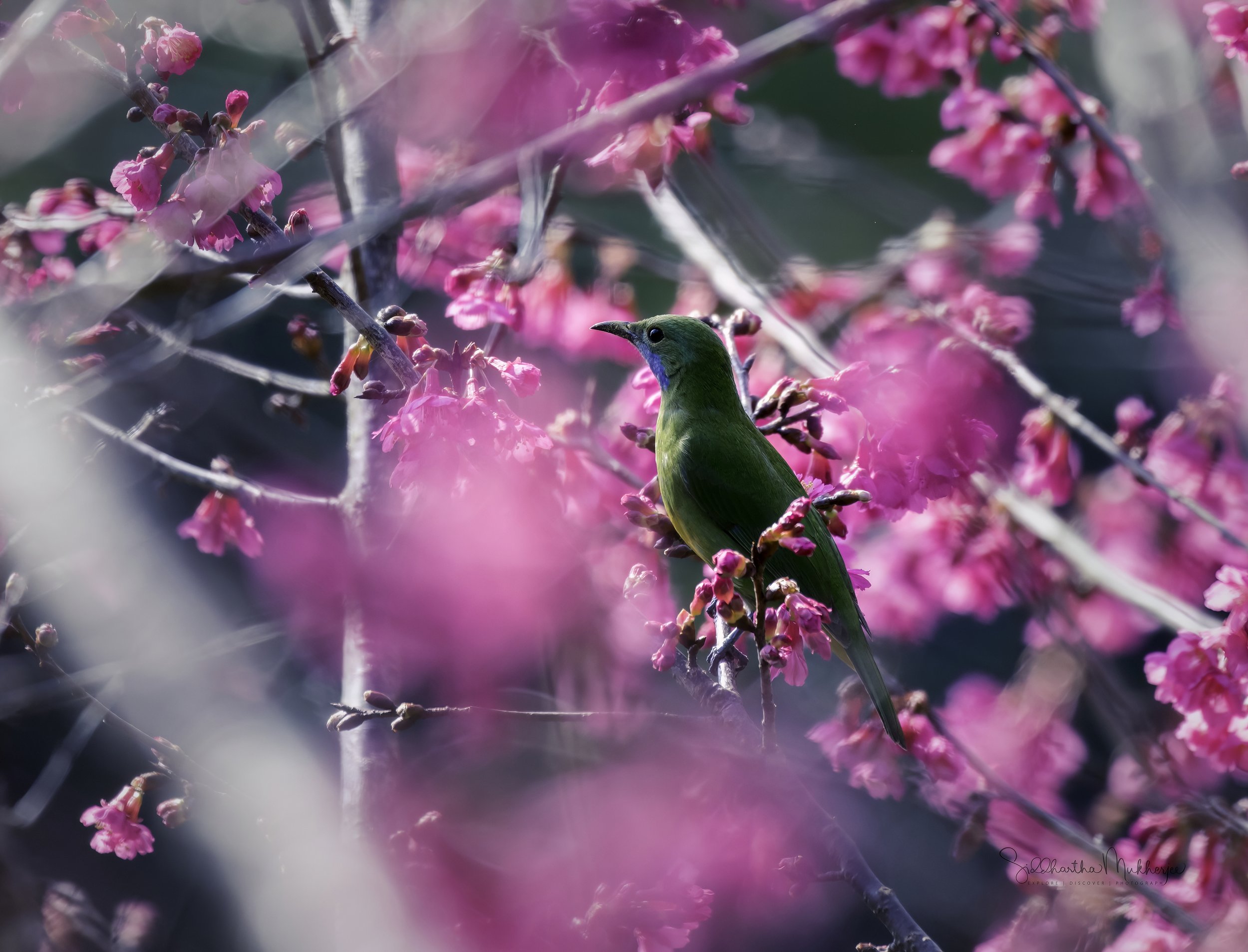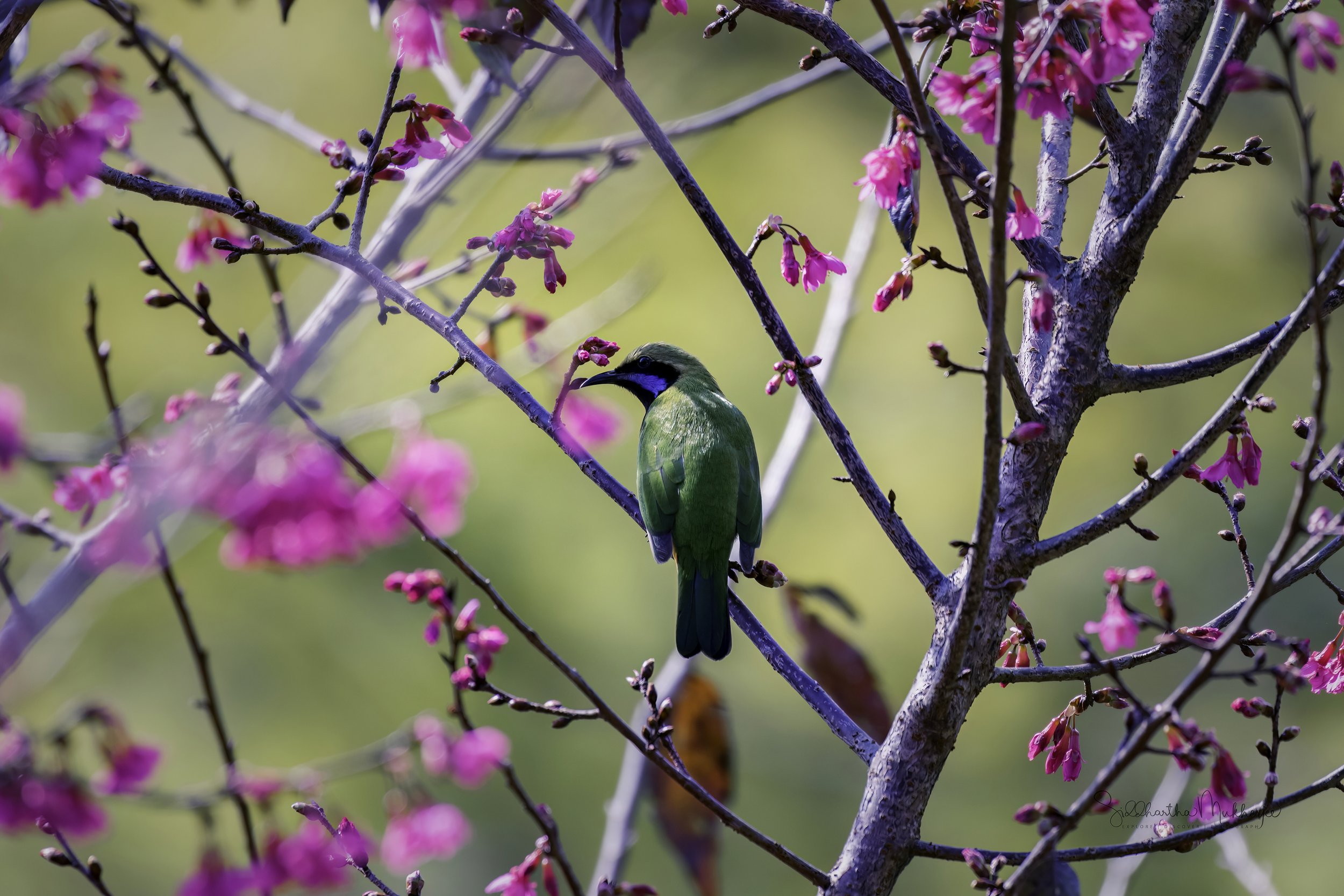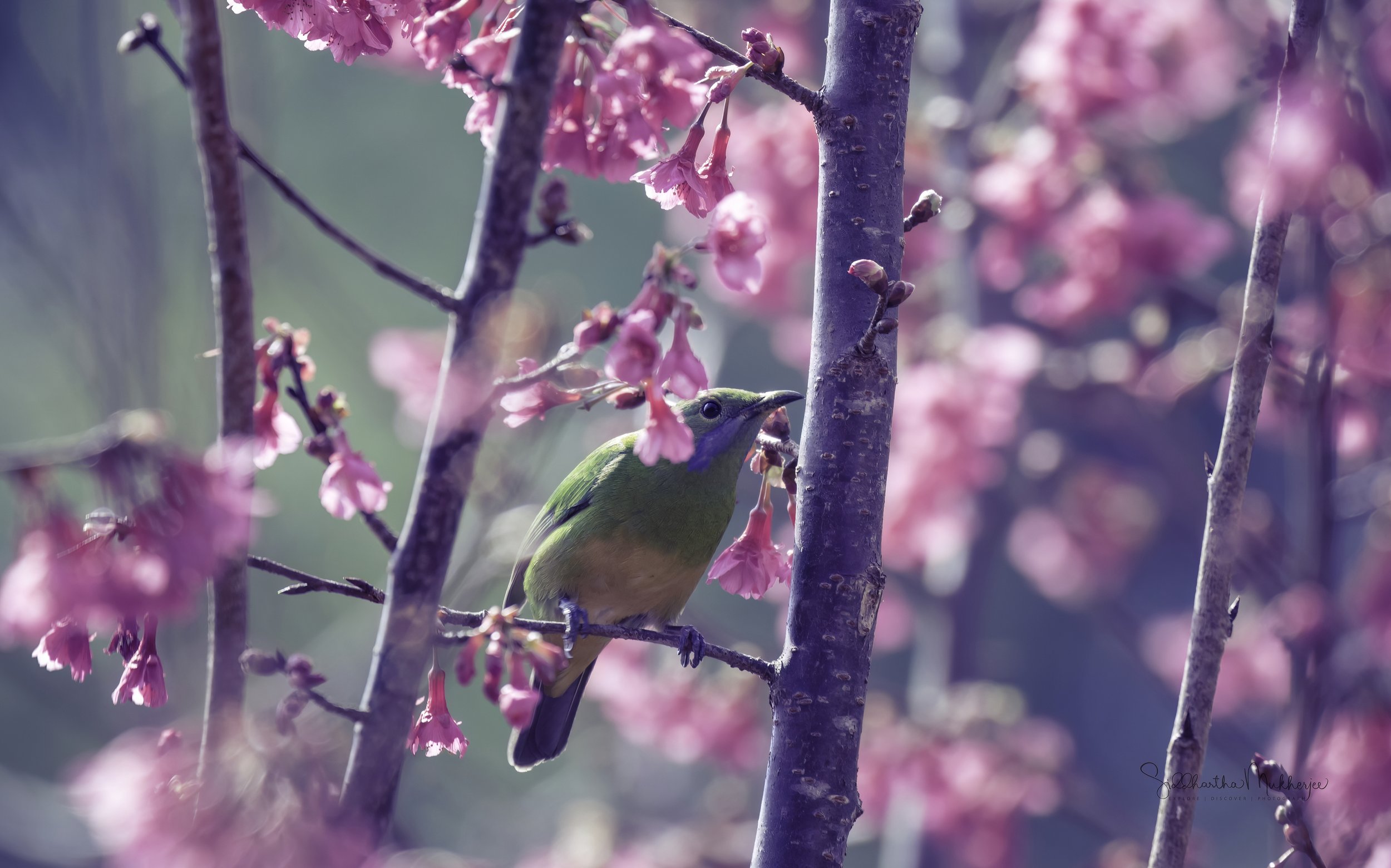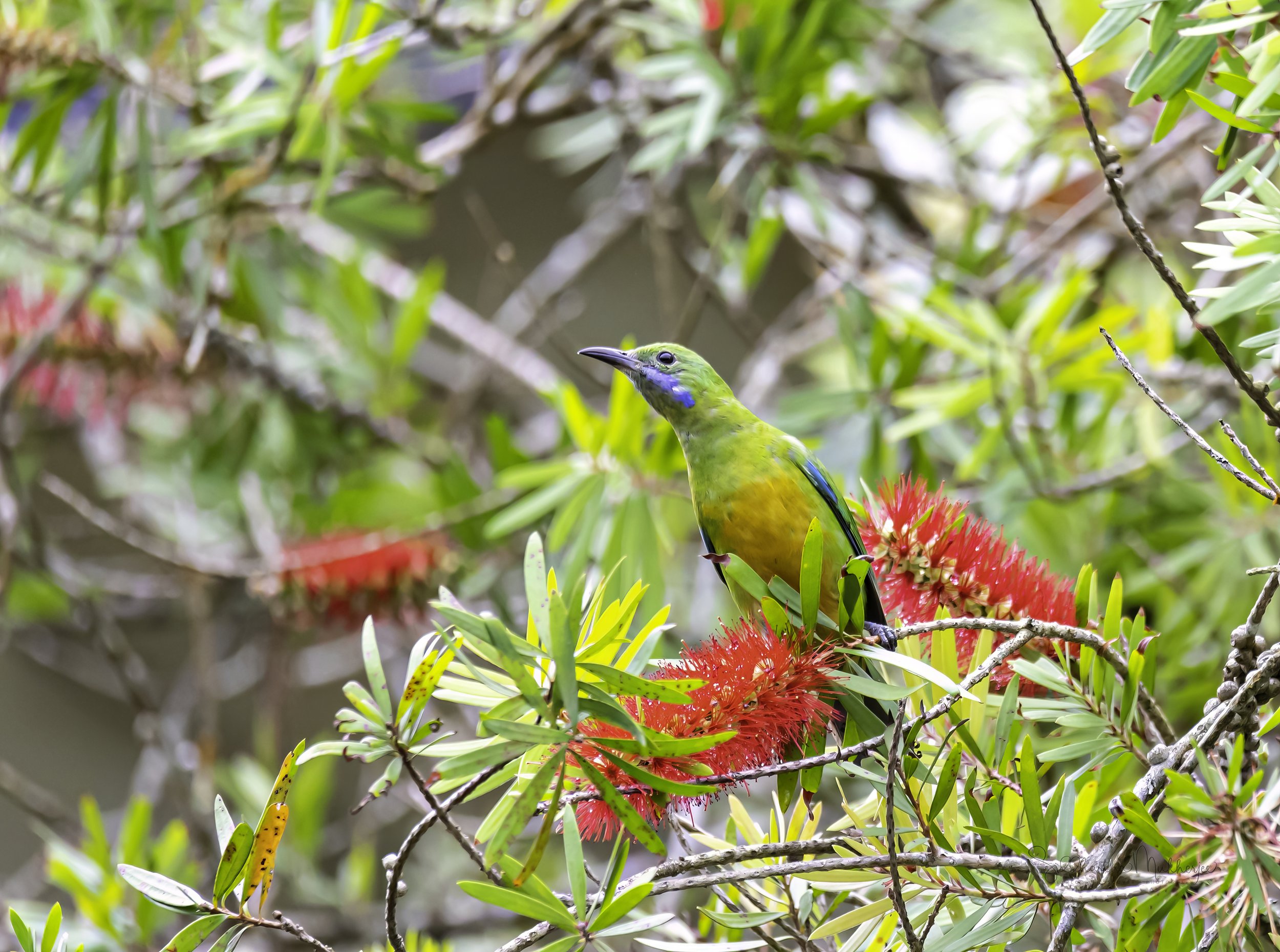Orange-bellied Leafbird
Chloropsis hardwickii
Narsapur Forest Range, Telangana & Doi Luang, Chiang Mai, Thailand
Another glamorous bird today - the spectacularly coloured Orange-bellied Leafbird - the only leafbird within its range with an orange belly. The orange-bellied leafbird is a bird native to the central and eastern Himalayas, Yunnan and northern parts of Southeast Asia. The scientific name commemorates the English naturalist Thomas Hardwicke.
The Orange-bellied Leafbird is a colourful, outstanding songster of hilly woodlands in the Himalayas and subtropical mainland eastern and southeastern Asia. Males have the diagnostic combination of an extensive black mask, yellow-orange belly, and grass-green upperparts. Like most of its relatives, the females lack the black coloration. It is a generalist and acrobatic feeder - as some of my photos will show - that plays a key role in seed dispersal of flowering and fruiting plants. The eastern subspecies (lazulina/melliana) are often recognised as a separate species “Grayish-crowned Leafbird” (as Chloropsis lazulina) based on genetic divergence which aligns with plumage differences.
Being located in the Deccan Plateau in the central stretch, the prosperous state of Telangana has sub-tropical climate and the terrain consists mostly of hills, mountain ranges, and thick dense forests covering an area of 27,292 km². The annual rainfall ranges between 1,100 mm to 1,200 mm and the annual temperature varies from 15 C to 45 C. The state is drained by a number of rivers which include the Godavari and the Krishna.
Telangana is endowed with rich diversity of flora and fauna. It has dense teak forests on the northern part along the banks of river Godavari. As per the Champion & Seth Classification of Forest Types (1968), the forests in Telangana belong to three Forest Type Groups, which are further divided into 12 Forest Types. The State Government has taken up a massive greening programme, 'Telangana Ku Harita Haram' in the State to plant and protect 230 crore seedlings over a period of 4 years. This initiative aims at achieving the twin objectives of increasing the forest cover and reduce pressure on the existing forest resources, through massive community participation by Vana Samrakshna Samithis (VSS) and Eco-Development Committees (EDCs) in Protected Areas and Watershed Development Committees in the Watershed areas. Recorded Forest Area (RFA) in the State is 26,904 km² of which 20,353 km² is Reserved Forest, 5,939 km² is Protected Forest and 612 km² is Unclassed Forests. In Telangana, during the period 1st January 2015 to 5th February 2019, a total of 9,420 hectares of forest land was diverted for non-forestry purposes under the Forest Conservation Act, 1980 (MoEF & CC, 2019). As per the information received from the State during that last two years, 12,730 ha of plantations including avenue plantations in the State.
Three National Parks and nine Wildlife Sanctuaries constitute the Protected Area network of the State covering 5.08% of its geographical area.
The Narsapur forest range is spread over 30 km² at an easily drivable distance of 45 km from Hyderabad, the state capital. It is brimming with a plethora of exquisite and fragrant flora and fauna, natural rock formations and ponds. Located in the Medak district, the Narsapur forest is at its best during the monsoons. There are small steep elevations which are easy to climb and invariably most of these begin at a temple in the forest. There is also the Narsapur Forest Urban Park with a watchtower in close proximity which provides stunning views of the whole forest. Our sojourn starts at one of these temples just off the highway where we park our cars and trek into the forest. The area surrounding and in close proximity of the temple is teeming with bird life and if one has the patience one is assured of spotting numerous species as they forage in the foliage.
Read about some of the other birds of these forests.
The Dois of northern Thailand have been very kind to me from a birding perspective. There are so many I have already talked about and so many still remaining. I have written an overview here on the Birds of the Dois and have now started to break them up into individuals like the Gray-backed Shrike, Long-tailed Shrike, Spectacled Barwing, Siberian Rubythroat, the stunning Mrs. Gould’s Sunbird and the numerous other birds I have seen here.
About 685 kilometers to the north of Bangkok lies the former seat of the ancient Lanna Kingdom and is considered one of the most scenic provinces in the country given its mountain ranges, valleys, flora and fauna. A land of misty mountains and colourful hill tribes, a playground for seasoned travellers, and a delight for adventurers. Despite its relatively small size and blissful calm, Chiang Mai truly has it all, a city that is still firmly Thai in its atmosphere and attitude. It is the second-largest changwat (province) of Thailand. Bordered by Chiang Rai to the northeast, Lampang and Lamphun to the south, Tak to the southwest, Mae Hong Son to the west and the Shan State of Myanmar to the north. Located in a verdant valley on the banks of the Ping River, Chiang Mai was founded in 1296 as the capital of the ancient Lanna Kingdom. Today it is a place where past and the present seamlessly merge with modern buildings standing side by side with venerable temples. Of all the places I have visited in Thailand, Chiang Mai with its forests and mountains and the historic city of Ayutthaya are by far my favourites.
The word Chiang itself is from North Thai, or Lanna, meaning town or city and Mai means new making Chiang Mai the New City as it was founded later than Chiang Rai, the earlier capital of King Meng Rai. The districts in the province are called amphoe, and sub-districts are called tambon. Another twist is the use of Nakhon (or Nakorn or Nakhorn), derived from the Sanskrit word Nagara, also means city, though strictly speaking it refers to a capital city such as Nakorn Sri Ayutthaya (more on Ayutthaya later). Indeed to emphasise its former status you may sometimes see Chiang Mai referred to as Nakhon Ping. Other common names of geographical features include mae (river) and doi which is north Thai for mountain - for example Doi Inthanon and Mae Ping.
The four Dois we spent our time on were Doi Inthanon, Doi Ang Khang, Doi Luang and Doi SanJu.
Doi Luang & Doi SanJu in close proximity to the Doi Pha Hom Pok National Park, it is the second highest mountain in Thailand and a part of the Dan Lao Mountain range, northwest of Chiang Mai, sharing the border with Myanmar. Doi SanJu, can be easily accessed from Fang town. The mountain forest and no traffic make it easy to view birds. The entire area is very quiet, secluded and home to rare species like Mrs. Humes Pheasant, Long–tailed Sibia, Himalayan Cutia, Black–throated Tit, Black–eared Shrike Babbler, Whiskered Yuhina, Crimson–breasted Woodpecker, Fire–tailed Sunbird to name a few.
We didn’t have the good fortune to see all the species on all the mountains, that would have been impossible, but we did rack up quite a number of species - about 95 of them. This gallery is of the tiny, unobtrusive and retiring White-gorgeted Flycatcher who keeps to the dense lower levels of foothill forests.
Read about the other birds from these beautiful mountains. These are only a few of the huge number I have spotted and recorded there.
Orange-bellied Leafbird
The Orange-bellied Leafbird (Chloropsis hardwickii) is a colourful, outstanding songster of hilly woodlands in the Himalayas and subtropical mainland eastern and southeastern Asia. The males have the diagnostic combination of an extensive black mask, yellow-orange belly, and grass-green upperparts. Like most of its relatives, the females lack the black coloration. It is a generalist and acrobatic feeder that plays a key role in seed dispersal of flowering and fruiting plants. The eastern subspecies (lazulina/melliana) are often recognised as a separate species “Grayish-crowned Leafbird” (as Chloropsis lazulina) based on genetic divergence which aligns with plumage differences.
The Orange-bellied Leafbird is a fairly large leafbird with a slightly more downcurved beak than other species. The females of western and southern taxa and males are readily separated from congeners by their dull orange to rich yellow belly and undertail coverts. Males possess a black bib which extends further onto the breast than other species. The forehead of the male sometimes appears silvery, presumably related to feather age. Both sexes also differ from other leafbird species in having blue outer primaries, secondaries, wing coverts, and tail, especially deep blue contrasting with the green body coloration in male.
The Orange-bellied Leafbird is most confusable with the female and juvenile plumages of other leafbird species (Chloropsis spp.). The orange-yellow patch on the belly is diagnostic of the adult Orange-bellied Leafbird except for females in the eastern part of their distribution. The male has black on throat extending more horizontally past the eye onto sides of the neck and breast than other species. In addition, the female has a larger blue moustachial stripe than other species. In the eastern part of their range, where sympatric only with Blue-winged Leafbird (Chloropsis cochinchinensis) and Golden-fronted Leafbird (Chloropsis aurifrons), the Orange-bellied Leafbird can be distinguished by the grayish-blue rather than yellow-green crown. In addition, the mainland subspecies of Blue-winged Leafbird whose ranges overlap differ in having brighter green upperparts, and brighter blue outer wing and tail feathers. The Blue-winged Leafbird, the larger Greater Green Leafbird (Chloropsis sonnerati), and the smaller Lesser Green Leafbird (Chloropsis cyanopogon) have less down curved bills and are usually absent in upper montane forest. The latter two species lack any blue tinge in wing and tail that is present in the Orange-bellied Leafbird.
The Orange-bellied Leafbird is often split into two species based on marked differences in coloration aligning with phylogenetic analyses, which revealed a divergence of 4.01% in mtDNA. However, the subspecies C. h. lazulina has not been sampled, but it is presumed to be most closely related to the geographically closest subspecies C. h. melliana based on phenotypic similarities. Intergrades between the two distinctly different subspecies, C. h. hardwickii and C. h. melliana, have been reported in northern Laos and possibly southwestern China where their ranges overlap. The precise boundaries between subspecies are unclear. The range of subspecies C. h. malayana was suggested to extend up to at least southern Myanmar by Smythies and hilly regions along the Thai-Myanmar border are provisionally defined as the intergradation zone between C. h. malayana and C. h. hardwickii.
Populations of Orange-bellied Leafbird in the eastern part of the range distinctly differ from those in the west and the south in having bluish-gray crown rather than bronzy green and lacking the pale turquoise patches at the bend of the wing. Additionally, males have dark blue breasts, not black while the females differ in being virtually all-green in coloration, without any orange on the belly and undertail coverts as in the western part of range. The narrow yellow eye-ring is only present in female and juvenile plumages of western and southern taxa. There appears to be a clinal variation in body size of western populations, being largest in the Himalayas in the north, becoming gradually smaller on average in Myanmar and are smallest in Malaysia.
Four subspecies in two subspecies groups are recognized
Orange-bellied Leafbird (Orange-bellied) Chloropsis hardwickii hardwickii/ malayana
Chloropsis hardwickii hardwickii - Widespread from the eastern Himalayas through south-eastern Tibet, Yunnan (China), Myanmar, Thailand, to northern Laos.
Chloropsis hardwickii malayana - Widely regarded as endemic to Peninsular Malaysia, but disjunct populations in Tenasserim, southern Myanmar, are often assigned to this subspecies rather than C. h. hardwickii. The two subspecies may intergrade at least in south-eastern Myanmar and western Thailand. This subspecies resembles C. h. hardwickii but is smaller in size with a less bronzy crown.
Orange-bellied Leafbird (Grayish-crowned) Chloropsis hardwickii lazulina/ melliana
Chloropsis hardwickii melliana - Found in south-eastern China, predominantly from Guizhou and Guangxi east to Zheijang, south through central and north-eastern Laos to central Vietnam. Populations in southern Annam, Vietnam, may be best described as a separate subspecies. This subspecies, along with C. h. lazulina, distinctly differs from C. h. hardwickii and C. h. malayana in having a bluish-gray crown and lacking pale turquoise shoulder-patches in both sexes, with the male having a dark blue breast and the female having all-green underparts.
Chloropsis hardwickii lazulina - Hainan Island, southern China. Like C. h. melliana but the bill is slightly longer.
The Orange-bellied Leafbird ranges from Himachal Pradesh in northern India, through the north-eastern Indian Subcontinent, Bangladesh, east to Zheijiang, south-eastern China, Hainan Island, Myanmar, northern and central Laos, Vietnam (except the extreme south), western, northern, and north-eastern Thailand, south to Peninsular Malaysia. The origin of the population in Hong Kong, first recorded in 1934, is debatable as they were also introduced to the area. Likewise, populations in Taiwan may have originated from escapees. Sightings in Singapore are assigned exclusively to escapees. The first sighting and breeding records from Hong Kong were in 1934 and 1989, respectively. It has evidently spread in 1990s with forest maturation. In Bhutan the first confirmed breeding record was 2005.
The Orange-bellied Leafbird inhabits the canopy and edge of broadleaved evergreen forest, forest edge, secondary growth, and parks and gardens of the montane ecotone. It shows a preference for forested habitats over rubber plantations. It mainly breeds between 600 m and 2,000 m elevation in the Himalayas, but has also been recorded as high as 2,300 m in the Kumaon Himalaya, Uttar Pradesh and Askot, Uttarakhand, 2,400 m in Eaglenest Wildlife Sanctuary and Sessa Orchid Sanctuary, Arunachal Pradesh, and also recorded down to 400 m in eastern part of Arunachal Pradesh. It occurs from below 900 m to approximately 2,800 m in Sikkim. It is recorded mainly from 450–1,800 m in northern Myanmar, 600–2,000 m in Thailand, up to 1,900 m in Peninsular Malaysia and to 2,136 m in the rest of the mainland south-eastern Asia. When visiting forest-edge fruit sources, Orange-bellied Leafbird descends to 820 m in Peninsular Malaysia and 500 m in western Myanmar, with some local records down to 400 m and foothills in Kaeng Krachan National Park, south-western Thailand. The eastern group (“Grayish-crowned Leafbird”) mostly occurs above 1,000 m, but recorded at 800–1,250 m in Ha Giang, Vietnam, and as low as 100 m at Son Tung, north-central Vietnam, and Hainan province, off southern China.
‡‡‡‡‡
Related Posts

